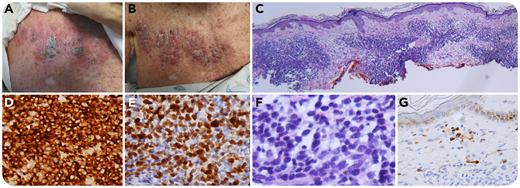An 88-year-old man with stage 0 chronic lymphocytic leukemia (CLL) developed polymerase chain reaction-proven, varicella-zoster virus (VZV) along the T1 dermatome, treated with acyclovir (panel A). He improved, but 9 weeks later had large pink nodules in the same distribution as the zoster (panel B). Biopsy was CD20+, CD3−, CD5+, CD23+, Bcl-2+, and MUM1+, consistent with a “histologically aggressive CLL” (panel C, ×4 objective, total magnification ×40; panels D-F, ×40 objective, total magnification ×400); a VZV stain was positive (panel G, ×40 objective, total magnification ×400). He refused palliative radiation, and subsequently expired from multiple issues.
The Wolf isotopic response describes the occurrence of a dermatological abnormality in the site of a previously healed dermatological abnormality. Koebner isomorphic response describes this in a nonhealed skin abnormality. There are infrequent references about the occurrence of CLL in the site of VZV in patients with known CLL. Abnormal skin changes have occurred at the onset of, or after healing of the VZV from days to months. Most cases improve with no treatment, chemotherapy, steroid cream, or radiation. Proposed mechanisms of this include immune dysregulation as a nidus for lymphoproliferative disorders. Our patient’s course was consistent with Wolf isotopic/Koebner isomorphic response. Because these lesions may occur peri-healing from VZV, one might call this the Wolf-Koebner “isomopic”response.
An 88-year-old man with stage 0 chronic lymphocytic leukemia (CLL) developed polymerase chain reaction-proven, varicella-zoster virus (VZV) along the T1 dermatome, treated with acyclovir (panel A). He improved, but 9 weeks later had large pink nodules in the same distribution as the zoster (panel B). Biopsy was CD20+, CD3−, CD5+, CD23+, Bcl-2+, and MUM1+, consistent with a “histologically aggressive CLL” (panel C, ×4 objective, total magnification ×40; panels D-F, ×40 objective, total magnification ×400); a VZV stain was positive (panel G, ×40 objective, total magnification ×400). He refused palliative radiation, and subsequently expired from multiple issues.
The Wolf isotopic response describes the occurrence of a dermatological abnormality in the site of a previously healed dermatological abnormality. Koebner isomorphic response describes this in a nonhealed skin abnormality. There are infrequent references about the occurrence of CLL in the site of VZV in patients with known CLL. Abnormal skin changes have occurred at the onset of, or after healing of the VZV from days to months. Most cases improve with no treatment, chemotherapy, steroid cream, or radiation. Proposed mechanisms of this include immune dysregulation as a nidus for lymphoproliferative disorders. Our patient’s course was consistent with Wolf isotopic/Koebner isomorphic response. Because these lesions may occur peri-healing from VZV, one might call this the Wolf-Koebner “isomopic”response.
For additional images, visit the ASH Image Bank, a reference and teaching tool that is continually updated with new atlas and case study images. For more information, visit http://imagebank.hematology.org.


This feature is available to Subscribers Only
Sign In or Create an Account Close Modal